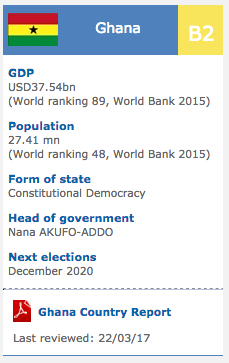Guinea-Bissau: Guinea-Bissau Energy Profile
2013/10/21

The Republic of Guinea-Bissau is a country in West Africa. It is bordered by Senegal to the north, and Guinea to the south and east, with the Atlantic Ocean to its west. It covers 36,125 km² (nearly 14,000 sq mi) with an estimated people of 1,600,000. Guinea-Bissau was once part of the kingdom of Gabu, inclunding part of the Mali Empire.
Parts of this kingdom persisted until the 18th century, while a few others were part of the Portuguese Empire since the 16th century. It again became the Portuguese colony of Portuguese Guinea in the 19th century. Upon independence, declared in 1973 and recognised in 1974, the name of its capital, Bissau, was added to the country\'s name to prevent confusion with the Republic of Guinea.
Only 14% of the people speaks the official language, Portuguese. 44% speak Kriol, a Portuguese-based creole language, and the remainder speak native African languages. The major religions are African traditional religions and Islam, and there is a Christian (mostly Catholic) minority. Guinea-Bissau is a member of the African Union, Economic Community of West African States, Organisation of Islamic Cooperation, the Latin Union, Community of Portuguese Language Nations, La Francophonie and the South Atlantic Peace and Cooperation Zone.
The country's per-capita gross domestic product is one of the lowest in the world.
Energy sources
Total installed electricity capacity (2008): 21 MW
Conventional Thermal generation makes up 100% of total installed capacity.
Electricity and water production and distribution in Guinea-Bissau have virtually collapsed since 2000. Only a small proportion of the people has access to public electricity and water supply, primarily in the capital Bissau, and only part of the time. The country’s entire public power system is operating on 5.5MW of generation capacity, 25% of what it had been before the 1998-99 internal conflict and equivalent to the capacity needed to supply less than 2000 people in the US.
Total primary energy supply (2008): 219 ktoe
Biomass: 49%
Oil: 51%
Guinea-Bissau has one of the lowest electrification rates and highest electric service cost in Africa. The country is completely dependent on petroleum products, despite its own high energy potential, particularly in terms of hydroelectric power.
Energy use in Guinea-Bissau is roughly 0.3 toe per person per year, and is one of the world’s lowest. The biomass represents over 95% of the total energy consumed by households in Guinea Bissau. Wood is the dominant fuel with a request that exceeds 500,000 tons per year, followed by charcoal being the majority-used fuel in the capital. The quantity of the biomass used is around 738,000 tons.
Reliance
Guinea-Bissau does not have any indigenous sources of oil, coal, natural gas or hydropower. Therefore, all petroleum products are imported, charging the country’s economy with high expenses. According to the energy balance of 2007, the consumption of petroleum products is mainly dominated by the transport sector (40.614 ktoe), followed by electricity production (0.946 ktoe) and the residential sector (0.240 ktoe). Oil consumption and imports are about 0.438 ktoe per day.
Guinea-Bissau relies on electricity imported from Senegal. Importing electric power produced in neighbouring nations into Guinea Bissau (e.g. from power plants built on the Gambia river, in Gambia and Konkouré in Guinea) is currently under discussion as are studies for the Saltinho dam on the Corubal river (power of 20 MW for an average production of 150 GWh/year).
Extend network
The situation in the electricity sector is a major problem. Only 20% of the people has access to public electricity, exclusively in major cities and towns and primarily in Bissau. Even in these areas, the electric company is only able to supply power 70% of the time.
Capacity concerns
The inefficiency of the power sector has disrupted economic activity to the point that a lot of business activities are forced to fasten their own generating capacity at high economic cost. The inefficiency of the power sector has as well had a direct negative impact on the water sector: the irregularity of water supply in Bissau is largely due to frequent power cuts which disrupt regular water pumping.
The electricity company EAGB, (Empresa Publica de Electricidade e Aguas da Guine Bissau) has major financial constraints, inclunding difficulty in collecting bills, inclunding problems with adequately trained personnel and availability of spare parts. [2] EAGB experiences technical and commercial losses that account for additional than 50% of the actual power generated. Most equipment is obsolete, outdated and not in use.
Renewable energy
Solar energy
Guinea-Bissau has an average solar radiation of 4.5 to 5.5 kWh/m2/day, over an average of 8 hours per day (3,000 h of insolation per year). In spite of this promising potential, up to presently only 450 kW of photovoltaic (PV) installations are installed, used for communication networks, water pumping stations and home lighting. The government plans to significantly increase the utilization of PV in order to cover up to 2 % of in general energy consumption by 2015.
Wind energy
The average wind speed is estimated at 2.5 to 7 m/s along the coast and on some of the islands. Even though there is a very promising potential, there are no plans for utilization of wind power in Guinea-Bissau so far.
Biomass energy
The forest areas of Guinea-Bissau are estimated at two million hectares. The available biomass resource is roughly 48.3 million m3. The annual consumption of wood for energy purposes is estimated at 625,000 m3 and leads to a significant reduction of existing forest areas. The available biomass potential from agricultural products, wood processing residues and livestock manure is about 67,000 m3 per year. In terms of biofuel production, there is a potential of roughly 10,000 m3 from cashew, and about 20 hectares of jatropha plantations.
Geothermal energy
No study has been conducted into the geothermal potential of Guinea-Bissau, and there is no current utilisation of the technology in the country.
Hydropower
The available hydropower potential of Guinea-Bissau is estimated at about 184 MW from the rivers Corubal and Geba. Even though there is a very promising potential available, up to presently there is no significant use of hydropower in Guinea-Bissau.
Tidal
A major natural resource of Guinea-Bissau is the high price of tidal range experienced on its coast, the highest along the west African coast. Moreover, the presence of tidal estuaries further enhances the tidal range: its maximum recorded price is 6.80 m in Porto Gole, on the banks of Rio Geba.
Energy efficiency
Energy consumption per capita stands at 0.068 toe. Sustainable consumption of the country\\\'s forest resources is a concern to the government, with the country having lost 8.1% of its forested area in the period 1990-2005.
Ownership
Electricity market
The electric system of Guinea-Bissau is managed by the Electricity and Water Company of Guinea-Bissau (Electricidade e Aguas de Guinea-Bissau, EAGB). EAGB is owned by the national government and is responsible for 90% of power production, with the remaining 10% originating from small, independent power producers.
Liquid fuels market
Prices of petroleum products are determined by the Ministry of Energy and Industry, and revised on a monthly basis. Guinea-Bissau’s downstream oil industry is all dependent on refined petroleum products imported from neighbouring nations. There has been active offshore exploration in the country since the late 1960’s, at the same time as Esso drilled six wells. However, offshore exploration has been hampered by a boundary dispute with Senegal, which was not resolved until 1995, and repeated civil unrest. The national oil company is PetroGuin (before Petrominas) is responsible for importing and distributing all petroleum products, and is jointly owned by Guinea Bissau and Portugal.
Competition
Electricity is provided by EAGB, which controls the production, transmission and distribution of power in the capital, and sets the tariffs for electricity service throughout the country.
Because of the failure of EAGB’s supply, there is an estimated 20 MW of private capacity installed by large consumers such as embassies, international organizations, hotels and other institutions. There are as well an estimate of 800-1000 small generators used in the residential sector. This is costly to the fragile economy of Guinea-Bissau in terms of competitiveness and has a negative environmental impact as small diesel generators are additional costly and less energy efficient than larger utility-run plants. The customer base is very small because of the lack of public supply and there are only about 19,000 customers for electricity and about 7,000 for water.
PetroGuin is a parastatal, vertically-integrated organisation, with a monopoly in the upstream oil market.
Energy framework
Major reforms were approved in 2010 as part of the implementation of the Sector Development Policy Paper to:
- Improve access to electrical energy by extending the distribution grid and by implementing a policy with prices that are accessible for the majority of the people;
- Give incentives for private investment for power generation and distribution, inclunding renewable energy, by implementing the public-private partnership law enacted in 2010;
- Implement a policy of innovative and differentiated rates that takes the different consumer categories into account, inclunding periods for amortizing investments and for economic competitiveness;
- Mobilize massive public and private financial resources to be invested in the energy sector to ensure 80% average coverage in urban areas and 60% at the national level by 2015.
- Launch the interconnection of the sub-regional grids and accelerate the implementation of the Rio Gambia Development Organisation program;
- Bolster training and retraining activities at all levels to improve the sector’s technical and technological competencies;
- Carry out an institutional and legal restructuring of the sector;
- Liquidate the EAGB and create a new entity for providing energy supply services;
- Create an entity to regulate the electricity and water sector;
- Adopt a strategy to optimize the various initiatives in evolution in the sector, such as the Rio Gambia Development Organisation program and making feasible the project to build the Saltinho Dam.
For the medium and long term:
- Continue to develop the country’s energy capacities, inclunding as part of sub-regional initiatives that will foster access to additional low-cost hydropower;
- Encourage alternative energy sources as a means of reducing dependence on petroleum products;
- Promote access to modern energy services in the rural and semiurban areas.
In 2020, it is expected that the power grid will cover 80% of urban centres, as opposed to current 60% coverage in the country. For 2015, the targets are 60% and 35% respectively.
Energy debates
With the support of the World Bank, the Government is currently making efforts for the rapid restoration and development of electricity and water supply services in its capital city.
Energy studies
The country is member of the Common External Tariff (TEC) of the West African Economic and Monetary Union (UEMOA, http://www.uemoa.int), established in 2000. UEMOA is moving towards tax incentives that are additional favourable to the development of renewable energy, which it is committed to encouraging in all member states.
Along with Gambia, Guinea and Senegal, Guinea-Bissau is a member of the Gambia River Basin Development Organization. It seeks to spur economic development in the region. To boost electric output and thus reduce power shortages, the four nations are involved in a project to construct hydroelectric power plants in Senegal and Guinea, and integrating the power grids of the four nations.
Role of government
The energy sector is under the supervision of the Ministry for Trade, Energy, Industry and Environment, which is as well in charge of the promotion of renewable energy. A General Directorate of Energy (DGE) is in charge of the execution of this policy. Its tasks are the elaboration of the legal and regulatory orders, and their application. It is as well entrusted with the promotion of new technologies.
Government agencies
The development of local energy resources is controlled by the National Institute on Research and Applied Technologies (INITA) under the supervision of the Ministry for Natural Resources.
Energy procedure
The Government is planning to focus its efforts as follows:
- Increase power generation infrastructure and distribution systems, particularly for Bissau, the capital city, inclunding the implementation of current projects or projects presently in the negotiating phase with partners;
- Strengthen the EAGB’s technical and operating capacities and implement the institutional reforms required to grow the sector;
- Upgrade commercial management by raising the power use recovery rate from 40% to 70% or additional with the goal of financially stabilizing the EAGB (to this end, give priority to controlling illegal connections by strengthening the legal framework and by bolstering control capabilities);
- Revise the rate structure and introduce a prepayment system;
- Plan the sector’s development to meet next requirements, incorporating opportunities for development and grid interconnection under the Rio Gambia Development Organization (OMVG) and;
- Promote alternative domestic energy systems with better efficiency to stem the per capita use of firewood and charcoal, thus ensuring the sustainability of this crucial source of energy for the majority of the people;
- Promote energy efficiency: (i) in buildings, houses and in the industrial sector, to lower the all the country pays for oil and to meet the growing request for electricity; (ii) in the production and use of charcoal to preserve the country’s forestry resources;
- Implement a strategy for supplying family units with fuel to safeguard forestry resources inclunding public finances and the country’s balance of payments.
The World Bank’s USD 15 million Multi-sector Infrastructure Rehabilitation Project (MIRP) seeks to reactivate electricity generation and strengthen the national-owned electricity and water company, EAGB. In 2010, the EU financed a EUR 15 million project to create a distribution network throughout Bissau. Additionally, the government is contemplating a strategy to develop alternative domestic energy sources, inclunding hydropower from the water basin of the river Gambia.
Energy regulator
The government’s Ministry of Energy regulates the electricity industry. The government intends to create a rural electrification agency and a regulatory commission. The Ministry of Energy is as well responsible for regulation of the oil sector.
Degree of independence
The Ministry of Energy is a direct subsidiary of the government of Guinea-Bissau, with the Minister being appointed by the President, and funding being allocated from the national budget.
Regulatory framework
The governmental body in charge is the Directorate General for Energy. Up to presently, however, all projects and incentives in the field of Renewable Energy (RE) were realised by the investors without any involvement of the Ministry of Energy or the Directorate General for Energy. In terms of feed-in tariffs and other mechanisms for the promotion of RE, there are no laws or regulations.
Regulatory roles
At the regulatory level, the Ministry of Energy delivers import and export licenses for all types of energy products and technologies. The Ministry is as well responsible for setting the monthly-reviewed electricity tariff structure.
Energy regulation role
No other government department takes a role in energy regulation in the country.
Regulatory barriers
Up to presently, there are no regulations, incentives or legislative framework conditions that support the implementation of renewable energy (RE) in Guinea-Bissau. It is planned to create regulations that allow private operators to get involved in rural electrification, thus offering opportunities for the utilization of RE.
The majority critical technical barrier is the lack of accurate data on available RE resources.
Overview data for Guinea-Bissau
-- = Not applicable; NA = Not available; E = Estimate value
Sources: EIA. For more detailed data, see International Energy Statistics.
Data last updated: May 30, 2013
- Guinea-Bissau News
-
- AFGHANISTAN: UNWTO: International tourism – strongest half-year results since 2010
- BOTSWANA: Why governments need to support the financial sector to meet the unserved needs of smallholder farmers
- BOTSWANA: International Arrivals To Africa Reach More Than 18 Million In 2017
- BOTSWANA: Africa: USA-Africa - No Policy? Bad Policy? or Both?
- BOTSWANA: Africa: U.S. State Department To Get Experienced Diplomat in Key Africa Post
- BOTSWANA: Africa’s economic growth in 2016 was driven by East Africa
- Trending Articles
-
- SOUTH AFRICA: Nigeria and South Africa emerge from recession
- WORLD: How fair is our food? Big companies take reins on sourcing schemes
- ANGOLA: Angola: Elections / 2017 - Provisional Data Point Out Qualified Majority for MPLA
- BAHRAIN: Bahrain issues new rules to encourage fintech growth
- NIGERIA: Nigeria has been one of the hardest-hit economies due to its over-dependence on oil
- KENYA: Kenya's overall inflation rate rises by 8 pct in August






.gif?1356023993)






